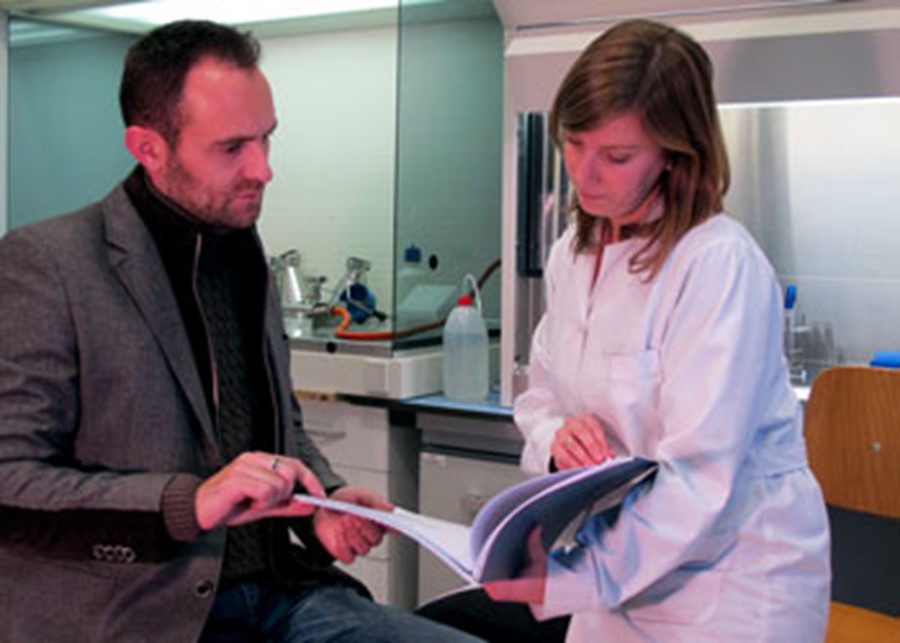Graphene Additives improves Industrial-Scale Resins
Research and development conducted by Graphene Flagship partner Avanzare has led to a graphene product already in use in high-volume industrial composite applications, proving the benefits of graphene technologies.
The Graphene Flagship fosters innovation and technological success in a wide range of areas, with the aim of translating technologies based on graphene and related materials into disruptive real world applications. An example of this kind of innovation comes from Graphene Flagship partner Avanzare Innovacion Technologica, based in Spain, which has successfully launched a graphene-based product that is already being used in high-volume industrial applications. The company specialises in production of high performance nanomaterials to be used as additives in composites such as plastics, resins and ceramics, giving multi-functional benefits to the composite materials.
The product, a graphene additive for resins, was developed in collaboration with Ashland, an international chemical manufacturing company with strong composites research and development in Europe. Graphene enhances the functionality of the resin, combining graphene’s electrical conductivity and mechanical strength with excellent corrosion resistance. The formulation and production of the high aspect ratio, low oxygen content graphene for the composite material is based on research and product development funded by the Graphene Flagship project. “We have a real, final product that is now in the market,” said Julio Gomez Cordon, founder and CEO of Avanzare. “This is an example of the future of graphene in a real industrial application.”
This new graphene resin can be used for corrosion-resistant tanks and pipes for storage and transport of potentially explosive chemicals – an application that was previously wholly dependent on metallic systems. “Due to the electrical conductivity of graphene, one can avoid explosions due to electrostatic charges,” explained Gomez Cordon. “Now, thanks to the graphene you can produce vessels and equipment in resins instead of the usual metals. The resins are also cheaper, lighter and with very good corrosion resistance. This is an example of multifunctionality in the combination of the resin plus graphene.” The production costs of the resin-based systems are significantly less than those of the metallic systems, leading to a 30% reduction in costs of the final product. The graphene-resin is already in use in chemical plants across Europe, and Ashland have installed graphene-resin systems in their facilities in Spain.

This is an example of the future of graphene in a real industrial application.”
CEO, Avanzare

Kari Hjelt (Chalmers University of Technology, Sweden) is the leader of the Innovation Work Package in the Graphene Flagship. Speaking of new resin composite, he said “The Avanzare collaboration with Ashland demonstrates the potential of graphene-based technologies to create market disruptions and transformational innovations. This case nicely exhibits graphene's unique capability to enhance multiple product attributes concurrently.”
After working in a research centre in the north of Spain, Gomez Cordon founded Avanzare in 2004. “We saw that there was a business opportunity in advanced nanomaterials – especially 2d materials, which are our speciality,” he said. “We founded the company with small resources. Now, we are close to 40 people, but we expect growth in the next few years.” A significant portion of this growth is fuelled by increasing commercial interest in graphene, fuelled by the Graphene Flagship. Gomez Cordon attributes much of the growth already seen to their involvement within the Flagship. “When we started in the Ramp-Up phase, we had 2,000 sq m of facilities. Now, we have over 6,000 sq m, and we are planning to have around 8,000 sq m by 2018. So, in just the first few years of the Graphene Flagship we have multiplied our capacity by four.”
Avanzare has been a partner of the Graphene Flagship since its inception in 2013. In the Graphene Flagship project, Avanzare is continuing to develop new graphene products for use in polymers and composite materials and optimise procedures for large scale production of graphene. As well as this, Avanzare supply graphene to other partners within the Flagship, for research including energy applications, biocompatibility, foams and coatings, and are highly active in benchmarking the various properties of graphene and graphene composites. Speaking of Avanzare’s contributions to the Flagship, Vincenzo Palermo (National Research Council (CNR), Italy), who leads the Graphene Flagship Work Package Polymer Composites and is a member of the Flagship Executive Board, said “We appreciate their deep knowledge of the industrial sector of additives for plastics, and their strong attitude to aim at concrete results, avoiding the hype often found at commercial level when dealing with innovative material such as graphene.”
Andrea Ferrari, Chair of the Graphene Flagship Management Panel and the Flagship’s Science and Technology Officer stated: "This is another example of the increasing success of the Graphene Flagship in taking graphene, related layered materials and hybrids from a state of raw potential to a point where they can revolutionize multiple industries, with a manifold return on the European investment, both in terms of technological innovation and economic exploitation. Over the next few years we will see more and more products enabled by graphene reaching the market, thanks to the support of the Graphene Flagship."
As well as the chemical industry, Gomez Cordon envisions potential for this resin and other graphene composites in other applications, including building and construction. He sees this as an excellent opportunity for Avanzare, planning to increase production capabilities to meet new demand. “We expect that high use will come around 2020, to start the big growth,” he said. Currently, Avanzare are producing graphene on a scale of 25 kg/day. “We need to go to 250 kg/day to be extremely competitive in price with all other carbons, replacement of metals and so on. The chemical industry is a scale-up cost economy. When you scale more the price of the product will decrease by several orders of magnitude.” Avanzare are demonstrating that graphene can successfully replace existing technologies by providing significant enhancement of performance at competitive prices.
Image credit: Ashland and Avanzare



